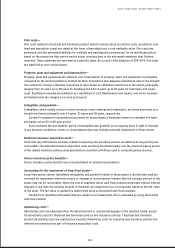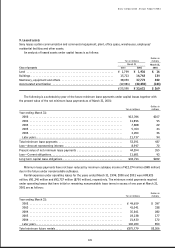Sony 2001 Annual Report Download - page 104
Download and view the complete annual report
Please find page 104 of the 2001 Sony annual report below. You can navigate through the pages in the report by either clicking on the pages listed below, or by using the keyword search tool below to find specific information within the annual report.
Sony Corporation Annual Report 2001
102
During the year ended March 31, 2001, Sony began expensing advertising costs for theatrical and television
product as incurred in accordance with SOP 00-2. Prior to the adoption of SOP 00-2, in accordance with Statement
of Financial Accounting Standards (“FAS”) No. 53, “Financial Reporting by Producers and Distributors of Motion
Picture Films” issued by Financial Accounting Standards Board (“FASB”), advertising costs for theatrical and
television product were capitalized and amortized over the related revenue streams in each market that such
costs were intended to benefit.
Income taxes—
The provision for income taxes is computed based on the pretax income included in the consolidated state-
ments of income. The asset and liability approach is used to recognize deferred tax assets and liabilities for the
expected future tax consequences of temporary differences between the carrying amounts and the tax bases of
assets and liabilities.
Derivative financial instruments—
Derivative financial instruments, which include foreign exchange forward contracts, foreign currency option
contracts, interest rate swap agreements, and interest rate and currency swap agreements, are used in Sony’s
risk management of foreign currency and interest rate risk exposures of its financial assets and liabilities.
a) Foreign exchange forward contracts:
Sony enters into foreign exchange forward contracts primarily to limit exposure, affected by changes in
foreign currency exchange rates, on inter-company accounts receivable and payable and cash flows gener-
ated from anticipated transactions denominated in foreign currencies. Foreign exchange forward contracts
which are designated and effective as hedges of such currency exchange rate risk on existing assets and
liabilities are marked to market and included as an offset to foreign exchange gains or losses recorded on
the existing assets and liabilities. Such contracts on anticipated transactions, including contracts used to
hedge inter-company foreign currency commitments, which do not qualify as firm commitments, are
marked to market with changes in value recognized in foreign exchange gains or losses.
b) Foreign currency option contracts:
Sony enters into purchased foreign currency option contracts primarily to limit exposure, affected by
changes in foreign currency exchange rates, on cash flows generated from anticipated inter-company
transactions denominated in foreign currencies. Sony also enters into written foreign currency option
contracts, of which the majority are part of range forward contracts corresponding to the purchased
foreign currency option contracts. In addition to the range forward contracts, Sony enters into written
foreign currency option contracts to minimize its hedging costs. The carrying values of all foreign
currency option contracts are marked to market with changes in value recognized in foreign exchange
gains or losses.
c) Interest rate swap agreements and interest rate and currency swap agreements:
Sony enters into interest rate swap agreements or interest rate and currency swap agreements in order to
lower funding costs, to diversify sources of funding and to limit Sony’s exposure in relation to underlying
debt instruments resulting from adverse fluctuations in interest rates or foreign currency exchange rates. The
related interest differentials paid or received under the interest rate swap agreements and under the interest
rate and currency swap agreements are recognized over the terms of the agreements in interest expense.
Currency swap portions of the interest rate and currency swap agreements which are designated and effec-
tive as hedges of exposure resulting from changes in foreign currency exchange rates on underlying debt
denominated in foreign currency are marked to market and included as an offset to foreign exchange gains
or losses on the underlying debt.
























